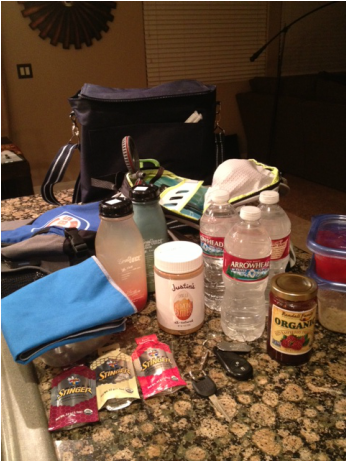PRE-RUN
The fun starts on Friday night. Anytime I have a long run on Saturday (I consider anything longer than 16 miles to be a "long run"), I try to eat a substantial dinner that is heavier in carbs than any other meal that week. Runner's World just posted a great pasta and avocado recipe which I've used the past few weeks. I load up on water during the day (no alcohol, especially in the summer months) and try to get to bed around 9pm. Laying out my clothes is helpful so I'm not fumbling in the dark come morning.
THE RUN
The alarm goes off at 3:40am.
After applying Body Glide to every imaginable crevice, I'm downstairs by 4:00. I eat a small bowl of steel cut oats with one tablespoon of almond butter and a dollop of raspberry jam. I eat first since I want the food to settle, usually about an hour before the run starts.
I pack:
Fluids: 55 oz of water in my Osprey pack, an additional 32 oz of bottled water, 12 oz of Gatorade, a protein/juice blend from The Juice Standard to consume immediately post-run, and watermelon juice to sip on for the ride home.
(Aside: Watermelon has so many amazing properties...it should be a staple in everyone's diet. I'm going to write a poem about watermelon one day.)
This amount may seem excessive but remember, I'm running in full sun in July in Las Vegas. It's 95 degrees by 8am. I've experienced dehydration before and would do anything to avoid that misery. I'd rather bring too much than not enough. Unless someone wants to set up little aid stations for me on the Loop, I'm going to tote around over 100 oz of fluid. It's kind of my security blanket.
Also included: a little tub of cut watermelon (ah, that magical fruit again!), a bag of sea salt, 2-3 gels, sunscreen, a visor, wallet, keys, music (iPod shuffle), Garmin, Body Glide, and a towel soaking in ice water.
Miles 1-7.7 are equally amazing and awful. The park doesn't open until 6am, so I'm guaranteed solitude from cars and cyclists for the first hour. It's also cooler since the path draped in the mountain's shadow. Little animals are still out and about, so it's not uncommon to rabbits and coyotes. I tried once to count the rabbits (to tell Scotty later), but had to stop after fifteen. They really do multiply like, well, rabbits.
The awful part? The first sevenish miles are mostly uphill. Tough, calf-burning, oxygen-gasping hills. There are moments when I wonder if I'm still moving forward.
Overlook Ascent signals the best part of the run is about to begin; miles 7.7 to 12 are my least remembered but most enjoyable. It's a lot of downhill flying. Running is just controlled falling, remember? This is when I try to practice good form and fast feet. I'm not breaking any land-speed records, but it's a incredibly sensation to zoom down literally as fast as my feet will take me.
Mile 12: Kim hits a wall.
The fun train has ended. I'm off the Loop, merging onto to Hwy 159. This is horrible for several reasons: the sun burns down, the cyclists whiz by, and I am trekking uphill again. I start my "Red Rock Shuffle" back to the car, dodging bikes and cars as they come within inches. At this point, my water is mostly gone and I can feel the salt crusted on my face. I mean, this is no Badwater shoes-melting-on-the-pavement-hot, but it sucks. Big time.
Mile 14.5: MY CAR!
I fight the voice in my head telling me to jump in my car and take off, never looking back. Unfortunately, there are still 5.5 miles to go, so no dice. I can't leave yet. I refill my pack with cold water, towel off (ahhh! bliss!) and have a few quick bites of watermelon. If I feel really thirsty or sluggish, I'll drink a quick Gatorade and add salt to the watermelon.
Salt may be a strange thing to eat at this point, considering how much is in the media about the dangerous affects of sodium, but for runners, salt lost through sweating is a real concern. Attempting to replenish fluids without additional sodium can result in hyponatremia, a potentially lethal condition. Overconsumption of water can actually cause blood sodium levels to plummet if the kidneys fail to compensate, causing cells to swell and retain fluid. This is why many ultras require weight checks at aid stations; if you gain weight during a long run, there's a good chance you are overhydrating. Too much swelling can affect brain cells, causing confusion, disorientation, and sometimes, even death. Yikes.
It's not something I'm especially concerned about (particularly because doing an easy 20 is nothing compared to say, 100 miles) but it is something to be aware of, especially in high heat. I don't want to dehydrate OR overhydrate - both can be equally dangerous. I'm still experimenting, so each run is a chance to practice.
Okay, enough salt talk. Back to the grind.
The rest of the run is a "chipper" - just gotta take it piece by piece. I know by mile 17.25 I can turn around and head back to the car. Mile 18 is only 2 miles from being done, and mile 19? Sheesh, it's one more stinkin' little mile. Anyone can run a mile. Or at least, these are the things I tell myself. Sometimes it's as simple as "Run to that pole. Run to the next pole. Hey look! There's another pole! Try to get to that one, too..."
Just keep chipping until...
DONE.
RECOVERY
I drink my protein shake as soon as I'm able to rip off the water pack and stretch a little. At about 250 calories, it's made with spirulina, a complete plant-based protein that will help with muscle repair. Better, it's cool and refreshing (despite its odd teal coloring.)
After I get home, I tell the guys about my run and try to recount for Scotty all the critters I saw. I shower and get an ice bath ready. I can usually handle about 10-12 minutes in the tub with 2 10-pound bags of ice. It's miserable, yes, particularly the first two minutes, but it helps so much to push the lactic acid out of the muscles, thereby decreasing soreness. Consequently, it's worth it. I also sip on a cup of tea to stay warm(er) and wear a ski hat to prevent more heat loss. Funny how I go from too hot to too cold. It's just never the right temperature...
I struggle with eating the day of a long run. I think my stomach is convinced we were fleeing from a hungry bear, so the whole "fight-or-flight" survival mechanism, which shunts blood away from my internal organs to the extremities, takes a little time to turn off. I don't feel any hunger most of the day, and eating actually causes physical pain; once I ate a piece of toast and immediately doubled over in pain. I've learned to stick with small bites of soup (southwestern black bean is my favorite) and bananas for the first six to eight hours post-run. It's gotten to the point where I actually wake up on Saturdays, craving those foods now. It's weird to think about dreaming about a bowl of hot soup at 10am on a Saturday morning in July (in the desert, no less), but do what works for you. We all have our "things."
I also make sure to wear compression socks for the first six to eight hours as well. If I'm staying home, I'll wear the full-on green ones that go from toe to knee. If I have to assimilate back into the real world where people don't count coyotes or swear at cyclists, I'll just wear the compression calf sleeves. I've learned these can be easily concealed under a maxi dress. I've worn them to toddler birthday parties, a baby shower, a hair appointment, and most recently, a trip to the mall with friends. A DVF wrap dress looks smashing when paired with compression sleeves.
I apply Neosporin to all the places I failed to Body Glide properly and call it a day. The long run is over for the week - celebrate!
Ironically, the body parts that seem to be bothering me the most lately? Right on my shoulder blades, where my hydration pack hits. Miles and miles of it jostling on my back have caused two small rubbed areas, red and chafed, to develop. It looks almost as though wings are about to sprout. That's not the case, but it certainly would make my life easier. :-)
Any helpful tips of your own? Let us know -- comment below!




 RSS Feed
RSS Feed